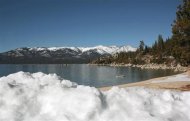
"These fish are competing with the native fish, and that's a big part of the problem," said Heather Segale, spokeswoman for the Tahoe Environmental Research Center at the University of California at Davis.
A group of researchers from Davis, the University of Nevada at Reno, and the fish and wildlife departments of both California and Nevada were the first to study the presence of goldfish in Lake Tahoe, beginning an annual survey in 2006.
In 2011, the group began a project to reduce the number of goldfish and other non-native fish from the lake through "electrofishing," dangling metal wires from the bottom of a boat to stun fish with electrical current, then capturing the fish as they float to the surface.
Researchers then sort the fish, releasing native species and sport fish such as trout, and removing the rest.
The project has rid the lake of 50 to 60 goldfish a year since 2011, but their foraging abilities and potential to multiply means removal efforts must continue to keep populations under control, said Christine Ngai of the University of Nevada.
The influx at Tahoe, at the base of a world-class ski area in the eastern Sierra Nevada mountain range, is believed to have originated from specimens dumped from a fish bowl by pet owners who no longer wanted them.
Some used as bait may also have escaped into the lake over time, Ngai said. Goldfish, members of the carp family, are known to grow in size when they inhabit larger environments.
While their precise numbers are difficult to track, the proliferation of large goldfish in the wild is not unique to Tahoe. James Schardt, an invasive species expert for the U.S. Environmental Protection Agency, said he has received reports of giant goldfish in lakes from around the country, mostly from the Great Lakes.
"Goldfish are very good at getting what they need," Ngai said. "They can potentially compete with native fish for food, vegetation and bugs."
"Because they eat a lot, they also excrete a lot. They can transfer that into the water and encourage algae growth," she added, saying that could create murky water.
With a maximum depth of 1,645 feet and an average depth of 1,000 feet, the 22-mile-wide lake is the nation's deepest after Crater Lake in Oregon and the 10th deepest on Earth.
It is also one of the clearest in the world, with visibility recently measured to a depth of 70 feet, reduced from 100 feet when clarity readings were first taken in the 1960s, according to the U.S. Geological Survey.


No comments:
Post a Comment